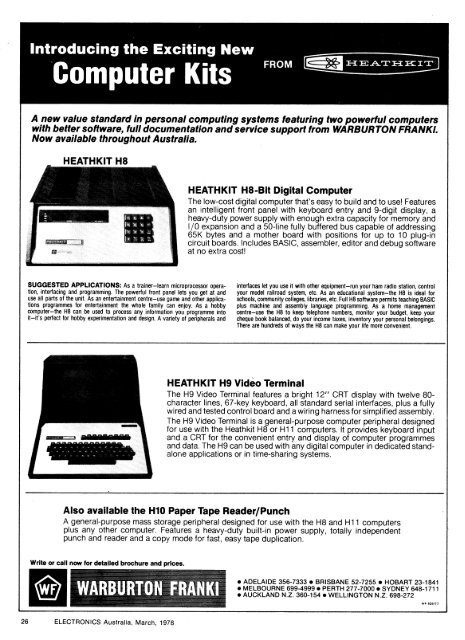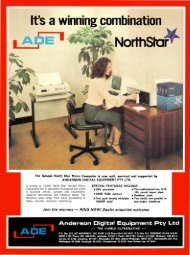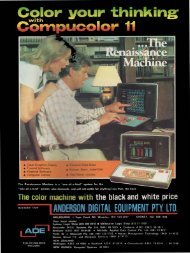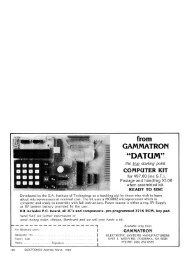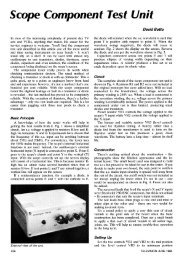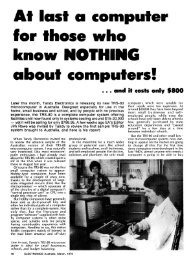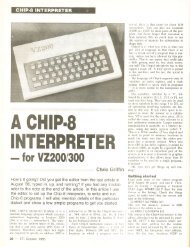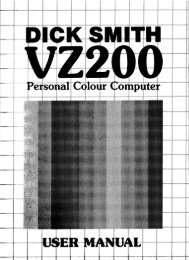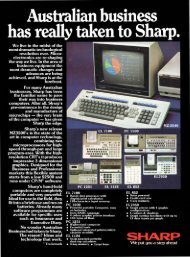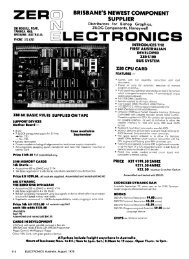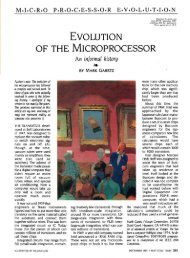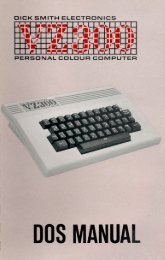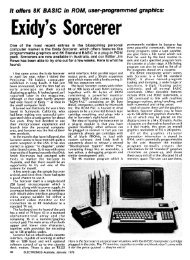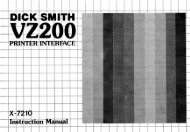Heathkit H8, H9, H10, H11, ET3400; Zenith Z89
Heathkit H8, H9, H10, H11, ET3400; Zenith Z89
Heathkit H8, H9, H10, H11, ET3400; Zenith Z89
Create successful ePaper yourself
Turn your PDF publications into a flip-book with our unique Google optimized e-Paper software.
A new value standard in personal computing systems featuring two powerful computers<br />
with better software, full documentation and service support from WARBURTON FRANK!.<br />
Now available throughout Australia.<br />
HEATHKIT <strong>H8</strong><br />
HEATHKIT <strong>H8</strong>-Bit Digital Computer<br />
The low-cost digital computer that's easy to build and to use! Features<br />
an intelligent front panel with keyboard entry and 9-digit display, a<br />
heavy-duty power supply with enough extra capacity for memory and<br />
I/O expansion and a 50-line fully buffered bus capable of addressing<br />
65K bytes and a mother board with positions for up to 10 plug-in<br />
circuit boards. Includes BASIC, assembler, editor and debug software<br />
at no extra cost!<br />
SUGGESTED APPLICATIONS: As a trainer—learn microprocessor operation,<br />
interfacing and programming. The powerful front panel lets you get at and<br />
use all parts of the unit. As an entertainment centre—use game and other applications<br />
programmes for entertainment the whole family can enjoy. As a hobby<br />
computer—the <strong>H8</strong> can be used to process any information you programme into<br />
it—it's perfect for hobby experimentation and design. A variety of peripherals and<br />
interfaces let you use it with other equipment—run your ham radio station, control<br />
your model railroad system, etc. As an educational system—the <strong>H8</strong> is ideal for<br />
schools, community colleges, libraries, etc. Full <strong>H8</strong> software permits teaching BASIC<br />
plus machine and assembly language programming. As a home management<br />
centre—use the <strong>H8</strong> to keep telephone numbers, monitor your budget, keep your<br />
cheque book balanced, do your income taxes, inventory your personal belongings.<br />
There are hundreds of ways the <strong>H8</strong> can make your life more convenient.<br />
HEATHKIT <strong>H9</strong> Video Terminal<br />
The <strong>H9</strong> Video Terminal features a bright 12" CRT display with twelve 80-<br />
character lines, 67-key keyboard, all standard serial interfaces, plus a fully<br />
wired and tested control board and a wiring harness for simplified assembly.<br />
The <strong>H9</strong> Video Terminal is a general-purpose computer peripheral designed<br />
for use with the <strong>Heathkit</strong> <strong>H8</strong> or <strong>H11</strong> computers. It provides keyboard input<br />
and a CRT for the convenient entry and display of computer programmes<br />
and data. The <strong>H9</strong> can be used with any digital computer in dedicated standalone<br />
applications or in time-sharing systems.<br />
Also available the <strong>H10</strong> Paper Tape Reader/Punch<br />
A general-purpose mass storage peripheral designed for use with the <strong>H8</strong> and <strong>H11</strong> computers<br />
plus any other computer. Features a heavy-duty built-in power supply, totally independent<br />
punch and reader and a copy mode for fast, easy tape duplication.<br />
Write or call now for detailed brochure and prices.<br />
26 ELECTRONICS Australia, March, 1978
Available in kit form, we review the .<br />
Heath <strong>H8</strong> home<br />
computer system<br />
The Heath <strong>H8</strong> Digital computer system has now been released in<br />
Australia. Based on the 8080A CPU central processing unit, it has<br />
provision for 64k of memory. A companion video terminal is also<br />
available, along with an audio cassette recorder, the complete<br />
system forming a self-contained home computer station.<br />
by DAVID EDWARDS<br />
Comprehensive software routines<br />
are available for the <strong>H8</strong> system, including<br />
a BASIC interpreter, a console<br />
debugger (BUG-8), a text editor (TED-<br />
8), and an assembly language (HASL-8).<br />
We will leave the discussion of these till<br />
later in the article, and concentrate first<br />
on the system hardware.<br />
The <strong>H8</strong> computer unit measures 406 x<br />
445 x 165mm, and weights 9.5kg. As will<br />
be apparent from the photographs, it<br />
has a sloping front and is fitted with an<br />
eight digit LED display and a 16-key<br />
keyboard. Four status LEDs are included<br />
on the left-hand side of the display.<br />
The power switch is fitted to the rear<br />
panel, • however, and is rather inconvenient<br />
to operate as a result.<br />
Internally, there is a mother board, a<br />
front panel board, and provision for<br />
seven memory or I/O boards, plus one<br />
bus expansion board. The unit supplied<br />
for review was fitted with three 8k RAM<br />
boards and one serial I/O board, as<br />
well as the CPU and PAM-8 monitor<br />
board.<br />
The unit is normally supplied with<br />
only 4k of RAM, and without the serial<br />
I/O board. Normally, it comes in full kit<br />
form, and is assembled by the user.<br />
The panel monitor, PAM-8, resides in<br />
a 1k ROM, and has the following<br />
features:<br />
• Memory contents display and alteration;<br />
• Register contents display and altera-<br />
tion;<br />
• Program execution control (both<br />
breakpoint and single instruction<br />
operation);<br />
• Self-contained bootstraps for<br />
program loading and dumping;<br />
• Port input and output routines.<br />
Instruction codes are entered via the<br />
keyboard and displayed via the displays<br />
in octal notation, with 16 bit numbers<br />
being treated in offset octal notation<br />
(i.e. 11111111 11111111 is coded as 377<br />
377 and not 177777). Codes are entered<br />
as three consecutive octal digits,<br />
without the use of any terminating key.<br />
As a result, all leading zeros must be<br />
entered. A cancel key is provided to<br />
enable erroneous keystrokes to be re-<br />
The mother board is at the bottom of the case, and Internally, the VDU is dominated by the cathode ray tube and the<br />
is fitted with PCB sockets.<br />
keyboard assembly.<br />
70 ELECTRONICS Australia, June, 1978
entered, an audible indication being<br />
provided for each keystroke. The<br />
decimal points of the displays are used<br />
to indicate the display mode (memory<br />
address, memory alter, register display<br />
and alter).<br />
The load and dump routines are intended<br />
for use with an audio cassette<br />
recorder, or with a paper tape punch<br />
and reader. Programs can be loaded<br />
and dumped with a single keystroke. A<br />
tape transport control facility is provided,<br />
along with error checking routines.<br />
The cassette recorderprovided is a<br />
self-contained 110V unit, which is<br />
powered from a convenience socket on<br />
the rear of the computer chassis. Three<br />
cables are provided to interconnect it<br />
with the <strong>H8</strong> unit.<br />
The <strong>H8</strong> can be used as a stand-alone<br />
computer, with data and programs<br />
entered via the keyboard, and results<br />
and outputs displayed on the LED displays.<br />
It uses the 8080A CPU chip, and<br />
can therefore be used with a large<br />
range of 8080 compatible software. The<br />
reference manual supplied with the<br />
system includes a listing of the instruction<br />
set, as well as a section on basic<br />
computer fundamentals.<br />
The companion <strong>H9</strong> Video Terminal<br />
has 305mm (dia.) cathode-ray tube, a 67<br />
key ASCII keyboard, and can communicate<br />
through a standard 20mA, HA<br />
or TTL serial interface, or through a<br />
parallel I/O interface. Overall dimensions<br />
are 397 x 527 x 318mm, and the<br />
weight is 14.5kg.<br />
The baud rate is user selectable to<br />
one of the following values: 110, 300,<br />
600, 1200, 2400, 4800 or 9600. Characters<br />
are displayed using a 5 x 7 dot matrix,<br />
allowable characters being upper case<br />
alphabetic,•numerals and punctuation.<br />
A total of 960 characters can be displayed,<br />
the normal mode being 12 lines<br />
of 80 characters. A plot mode is also<br />
available, which has 48 lines of 20<br />
characters. Other features include<br />
automatic scrolling, cursor controls,<br />
erase to end of page, short form (four<br />
12 line columns of 20 characters),<br />
automatic line carry-over, built in audible<br />
bell, transmit page.<br />
The operation manual supplied with<br />
the unit contains full details of the<br />
various options and controls, including<br />
detailed instructions for any alterations<br />
that may be required.<br />
Four software routines are supplied<br />
with the <strong>H8</strong> system. The first of these is<br />
the BUG-8 Console Debugger, which is<br />
designed to allow machine language<br />
programs to be entered and debugged<br />
from the video terminal unit.<br />
BUG-8 contains facilities to perform<br />
the following major functions:<br />
• Display and alter the contents of a<br />
selected memory location;<br />
• Display and alter the contents of any<br />
8080 register;<br />
• Insert and execute breakpoints;<br />
• Execute programs;<br />
• Execute programs one step at a<br />
time;<br />
• Load and dump programs to and<br />
from tape storage.<br />
Memory locations and memory and<br />
register contents can be displayed as<br />
either bytes or words, and in octal,<br />
decimal or ASCII format. No provision<br />
is made for hexadecimal format.<br />
A text editing program called TED-8<br />
is provided, and is intended mainly for<br />
producing a source code for processing<br />
by the assembler program. However, it<br />
can also be used to produce error-free<br />
text, such as would be required for<br />
reports, letters and manuscripts.<br />
The next software package provided<br />
is the Heath Assembly Language, HASL-<br />
8. Thisprogram assembles a source<br />
program composed, using the companion<br />
editor program, into a binary<br />
program (the object code) for use by<br />
the CPU and a symbolic listing for use<br />
by the programmer.<br />
Two passes are required through the<br />
assembler, the symbolic listing being<br />
produced on the second pass, along<br />
with a list of any errors present. As well<br />
as recognising the standard )8080 opcodes,<br />
the assembler also recognises a<br />
number of pseudo opcodes, which are<br />
used to direct the operation of the<br />
assembler and to generate constants in<br />
the object code.<br />
The final software package, and<br />
perhaps the most interesting, is the<br />
conversational programming language,<br />
The complete home computer station<br />
is shown above, including the data<br />
storage system (the cassette recorder).<br />
BASIC. Two versions of this are<br />
available, Benton Harbour BASIC and<br />
Extended Benton Harbour BASIC.<br />
Extended BASIC provides for string<br />
manipulation, as well as more advanCed<br />
functions, but is otherwise similar to<br />
the unextended BASIC. Standard commands<br />
provided include CLEAR, FOR<br />
and NEXT, GOSUB and RETURN, IF<br />
THEN, IF GOTO, GOTO, LET, LIST, ON<br />
GOSUB, ON GOTO, PRINT, READ,<br />
DATA, REM, STEP, INPUT and STOP.<br />
A process called command completion<br />
is used with these commands.<br />
Once sufficient letters of a command<br />
have been typed so that the command<br />
is defined uniquely, the program takes<br />
over and fills in the remaining letters.<br />
This saves the programmer time, but<br />
does not save program storage space.<br />
The more normal system is to just to<br />
allow commands to be abbreviated,<br />
thus reducing program length. Integer<br />
and floating point numbers can be<br />
handled, with a range from 10 38 to<br />
10 37. The resolution is 6.9 digits.<br />
Variables are named by a single<br />
letter, or a single letter followed by a<br />
single number. Subscripted variables<br />
are allowed, as well gs string variables.<br />
Two commands, LOAD and DUMP,<br />
are provided for loading and dumping<br />
programs via cassettes or paper tapes.<br />
Programs can be given names, and the<br />
load routine will test eachprogram on<br />
the tape till a match with the specified<br />
name is found, and then automatically<br />
load it. A VERIFY command is also<br />
provided, to enable tapes to be checked.<br />
The documentation supplied with<br />
the units is quite comprehensive, but<br />
presumes a deal of knowledge on the<br />
part of the user. A newcomer would<br />
find it quite difficult to know just what<br />
the various software programs are used<br />
for, and would probably also have difficulty<br />
in actually using some of it.<br />
Further details regarding price and<br />
availability are available from the Warburton<br />
Franki agent in your capital city.<br />
ELECTRONICS Australia, June, 1978 71
Two, of the finest names in modem<br />
electronics, Heath and Digital<br />
Equipment Corporation (DEC)<br />
combine to bring you the world's first<br />
16-bit computer priced within reach<br />
of the general public!<br />
THE HEATHKIT<br />
00<br />
DIGITAL<br />
COMPUTER<br />
Heath and DEC join forces to bring you mini-computer performance at a microcomputer<br />
price! The <strong>H11</strong> features a fully wired and tested DEC KD11F board that contains the 16-bit<br />
LSI-11 CPU, 4096x 16 read /write MOS semi-conductor memory, DMA operation; and<br />
includes the powerful PDP-11 /40 instruction set, PLUS Heath / DEC PDP-11 software.<br />
Equivalent commercial versions of the <strong>H11</strong> would cost $1,000's of dollars morel<br />
The New Heath/DEC <strong>H11</strong> personal computer is one<br />
of the most powerful and sophisticated units available<br />
today! It combines the advanced, performance-proven<br />
hardware and software of the LSI-11 with Heath's expertise<br />
in kit design and documentation to bring you a<br />
personal computer of almost incredible power and flexibility.<br />
Equivalent commercial versions of the <strong>H11</strong> would<br />
cost over twice as much, and you still wouldn't get the<br />
superior documentation and support of the <strong>H11</strong>!<br />
POWERFUL HEATH/DEC PDP-11 SOFTWARE<br />
AT NO EXTRA COST!<br />
The Hil includes a sophisticated software system that<br />
lets you get your computer up and running with practical<br />
programming capabilities. This paper tape based software<br />
would cost over $1200 if purchased separately.<br />
A minimum of 8K memory is required to run the software.<br />
The programs include:<br />
ED-11. Assists you in the creation and modification of<br />
ASCII source tapes, also used to write assembly language<br />
programs and for general text editing or word<br />
processing functions.<br />
PAL-11 S. Relocatable assembler converts ASCII source<br />
tapes into relocatable binary modules. This lets you<br />
• create programs in small, modular segments for easier<br />
coding and debugging. These binary modules serve as<br />
inputs to LINK-11S<br />
NOTE: <strong>H11</strong> owners are eligible for membership in<br />
the Digital Equipment Computer User's Society<br />
(DECUS). This organization provides useful sym-<br />
LINK-11S. Link editor which links the modules created<br />
by the PAL-11S into a load module ready for execution<br />
on the H-11. The module is loaded into the H-11 via<br />
the Absolute Loader.<br />
Absolute Loader. Loads absolute binary tapes into the<br />
<strong>H11</strong> memory for execution.<br />
ODT-11 X. Lets you debug the programs which you have<br />
created. Permits modifying and controlling program<br />
execution "on the fly" for quick, efficient debugging.<br />
10X. Executive program permits I/O programming<br />
without developing device-driving programs. Links to<br />
your programs using the LINK-115. For use with high<br />
speed paper tape reader/ punch and line printer.<br />
DUMP-AB AND DUMP-R. Lets you dump absolute<br />
binary contents of memory into the paper tape punch.<br />
BASIC. DEC's powerful version of standard Dartmouth<br />
BASIC interpreter uses english-type statements and<br />
mathematical symbols to perform operations. Immediately<br />
translates, stores and executes the program.<br />
Includes string capability.<br />
FOCALTM. DEC's own interpretive computer language<br />
which combines simplicity with computing power. Ideal<br />
for most scientific, engineering and math applications.<br />
FOCALTM programs can be written and executed easily.<br />
Both 4K and 8K versions are included.<br />
posia, newsletters, program library and other useful<br />
information to help you get the most from your<br />
LSI-11 computer.<br />
• ADELAIDE 356-7333 • BRISBANE 52-7255 • HOBART 23-1841<br />
• MELBOURNE 699-4999 • PERTH 277-7000 • SYDNEY 648-1711<br />
• AUCKLAND N.Z. 360-154 • WELLINGTON N.Z. 698-272<br />
WF 560/17<br />
74 ELECTRONICS Australia, July, 1978
Two of the finest names in modern<br />
electronics, Heath and Digital<br />
Equipment Corporation (DEC)<br />
combine to bring you the world's firs<br />
16-bit computer priced within reach<br />
of the general public!<br />
THE HEATHKIT<br />
DIGITAL<br />
COMPUTER<br />
death and DEC join forces to bring you mini-computer performance at a microcomputer<br />
vice! The <strong>H11</strong> features a fully wired and tested DEC KD11F board that contains the 16-bit<br />
.SI-11 CPU, 4096x 16 read/write MOS semi-conductor memory, DMA operation; and<br />
ncludes the powerful PDP-11 /40 instruction set, PLUS Heath/DEC PDP-11 software.<br />
The new Heath/DEC <strong>H11</strong> personal computer is one<br />
of the most powerful and sophisticated units available<br />
today! It combines the advanced, performance-proven<br />
hardware and software of the LSI-11 with Heath's expertise<br />
in kit design and documentation to bring you a personal<br />
computer of almost incredible power and<br />
flexibility. Equivalent commercial versions of the <strong>H11</strong><br />
would cost twice as much, and you still wouldn't get<br />
the superior documentation and support of the Hil!<br />
POWERFUL HEATH/DEC PDP-11 SOFTWARE<br />
AT NO EXTRA COST!<br />
The <strong>H11</strong> includes a sophisticated software system that<br />
lets you get your computer up and running with practical<br />
programming capabilities. This paper tape based software<br />
would cost over $1200 if purchased separately.<br />
A minimum of 8K memory is required to run the software.<br />
The programs include:<br />
ED-11. Assists you in the creation and modification of<br />
ASCII source tapes, also used to write assembly language<br />
programs and for general text editing or word<br />
processing functions.<br />
PAL-115. Relocatable assembler converts ASCII source<br />
tapes into relocatable binary modules. This lets you<br />
create programs in small, modular segments for easier<br />
coding and debugging. These binary modules serve as<br />
inputs to LINK-11S<br />
LINK-11 S. Link editor which links the modules created<br />
by the PAL-11S into a load module ready for execution<br />
on the H-11. The module is loaded into the H-11 via<br />
the Absolute Loader.<br />
Absolute Loader. Loads absolute binary tapes into the<br />
<strong>H11</strong> memory for execution.<br />
ODT-1 1 X. Lets you debug the programs which you have<br />
created. Permits modifying and controlling program<br />
execution "on the fly" for quick, efficient debugging.<br />
10X. Executive program permits I/O programming<br />
without developing device-driving programs. Links to<br />
your programs using the LINK-11S. For use with high<br />
speed paper tape reader/punch and line printer.<br />
DUMP-AB AND DUMP-R. Lets you dump absolute<br />
binary contents of memory into the paper tape punch.<br />
BASIC. DEC's powerful version of standard Dartmouth<br />
BASIC interpreter uses english-type statements and<br />
mathematical symbols to perform operations. Immediately<br />
translates, stores and executes the program.<br />
Includes string capability.<br />
FQCALTM. DEC's own interpretive computer language<br />
which combines simplicity with computing power. Ideal<br />
for most scientific, engineering and math applications.<br />
FOCALTM programs can be written and executed easily.<br />
Both 4K and 8K versions are included.<br />
NOTE: <strong>H11</strong> owners are eligible for membership in the Digital Equipment Computer User's Society<br />
(DECUS). This organization provides useful symposia, newsletters, program library and other useful information<br />
to help you get the most from your LSI-11 computer.<br />
• ADELAIDE 356-7333 • BRISBANE 52-7255 • HOBART 23-1841<br />
• MELBOURNE 699-4999 • PERTH 277-7000 • SYDNEY 648-1711<br />
• AUCKLAND N.Z. 360-154 • WELLINGTON N.Z. 698-272 VVF 560/77<br />
ELECTRONICS Australia, October, 1978
Heath's H-11 16-bit<br />
minicomputer kit<br />
The recently-released <strong>Heathkit</strong> H-11 is the first fully professional<br />
16-bit minicomputer system to be made available as a kit. Based<br />
on the Digital Equipment LSI-11, it is able to make use of the vast<br />
amount of software available for the well-known PDP-11 series of<br />
computers. This review of the <strong>Heathkit</strong> H-11 has been written by an<br />
experienced user.<br />
by D. W. RICKARD<br />
Computer Centre, Australian Institute of Marine Science<br />
P.M.B. No. 3, MSO Townsville, 4810<br />
The <strong>Heathkit</strong> H-11 digital computer<br />
system is now available in Australia.<br />
Based as it is on the Digital Equipment<br />
Corporation (DEC) LSI-11 16-bit computer,<br />
this is the first fully professional<br />
mini-computer to be made available as<br />
a kit.<br />
Actually, to call the H-11 a kit is a bit<br />
of a misnomer. The LSI-11 central<br />
processor board comes completely<br />
assembled and tested by DEC, and includes<br />
an onboard 4K by 16-bit<br />
memory. The constructor only has to<br />
assemble the heavy duty switching<br />
mode power supply, the back plane<br />
and sockets, and the case. Total time to<br />
get a system operational is usually under<br />
30 hours.<br />
It is well to note that the H-11 does<br />
not include any form of terminal, either<br />
VDU or hard copy, nor does it include<br />
interfaces for these devices. Like all<br />
PDP-11 systems, the H-11 has available<br />
for connection to it a range of interfaces<br />
and I/O devices which must be<br />
ordered separately. For example, the.<br />
H-9 <strong>Heathkit</strong> VDU and the Heath H-36<br />
hard copy terminal factually a DEC LA-<br />
36 DECwriter II) are available and the<br />
H-11-5 serial interface to connect them<br />
to the LSI-11 bus. Similarly, the <strong>Heathkit</strong><br />
H-10 paper tape reader/punch combination<br />
is available with the H-11-2<br />
parallel interface module to connect to<br />
the LSI-11 bus. A 4K by 16-bit memory<br />
module, the H-11-1 is also available.<br />
A word of warning should be ,given<br />
about these boards. Due to the close<br />
spacing of boards on the back plane,<br />
the height of components must be kept<br />
to a minimum. However the 820pF<br />
capacitors supplied for +5V bypass exceed<br />
this height and foul the adjacent<br />
board. It is quite possible for the tops to<br />
be scraped off the capacitors and for<br />
the exposed metalisation to short out<br />
against the next board. If this happens<br />
to be the LSI-11 CPU board the results<br />
could be disastrous. It has been found<br />
that miniature .001 uF capacitors are an<br />
effective substitute.<br />
The construction documentation is<br />
up to the usual high standard of Heath.<br />
However, during construction of the<br />
power supply a couple of anomalies in<br />
component numbering will become<br />
apparent. These can be resolved with<br />
reference to the parts list.<br />
The software supplied with the H-11<br />
is in fact the standard DEC PTS (Paper<br />
Tape Software) system. It comprises ED-<br />
11 (a source editing program), PAL-11S<br />
(an assemblerproducing relocatable<br />
object modules), LINK-11S (which links<br />
together different object modules to<br />
produce an absolute binary load<br />
module), 10X (an input/output executive<br />
to be incorporated into user<br />
written programs), ODT (an octal<br />
debugging system), BASIC and FOCAL.<br />
Because of the use of the LSI-11, the<br />
H-11 is software compatible with the<br />
great range of PDP-11 computers, and<br />
much of this software can be run on the<br />
H-11. Note, however, that the PTS<br />
software requires as a minimum an<br />
ASR-33 teletype with paper tape reader<br />
and punch. This is only suitable for<br />
small program development, and any<br />
reasonable size programs really<br />
necessitate an LA-36 hard copy terminal<br />
and a separate high speed paper tape<br />
reader/punch.<br />
Most of the software will run in 4K x<br />
16-bit words but this sometimes leaves<br />
very little user space. BASIC is the worst<br />
offender, and should only be<br />
attempted in systems with 8K x 16-bit<br />
words or greater. FOCAL is an interpretative<br />
language somewhat like<br />
BASIC but can be extremely recursive,<br />
and because all commands can be cut<br />
to the first letter only, user storage requirements<br />
can be minimised. Because<br />
of its inbuilt scheduling facilities and<br />
powerful I/O facilities, FOCAL can be<br />
used for implementing quite high level<br />
The Heath H-11 is shown here in the centre, with the matching H-9 VDU to the left and the H-10 paper tape reader/punch to<br />
*he right. A hard copy terminal (H-36) is also available.<br />
ELECTRONICS Australia, December, 1978 97
Here the Heath H-11 is shown with an SMS dual floppy disc unit and a Micro-Tec<br />
model 70 video terminal. The H-11 runs a great deal of the software written for<br />
Digital Equipment PDP-11 computers.<br />
data acquisition or industrial control<br />
systems.<br />
One program which is not included<br />
in the Heath supplied set but can be<br />
obtained from DECUS, the DEC Users<br />
Society, is called PALEDIT. This is a<br />
combined editor-assembler which requires<br />
8K x 16-words in which to run. It<br />
allows both the editor, the assembler,<br />
and the user's source code to all be in<br />
memory at the same time. The editor is<br />
used to create assembler source code<br />
stored in memory. Then the user jumps<br />
to the assembler and assembles the<br />
source code also in memory. If any<br />
errors are found, you jump back to the<br />
editor, make the necessary corrections,<br />
back to the assembler, etc, until such<br />
time as an error free assembly is achieved.<br />
Due to the fact that the program<br />
only has to be loaded once, and that<br />
the assembler is getting its input from<br />
high-speed memory and not a paper<br />
tape reader, this is a tremendously fast<br />
system and worth some effort in bbtaining<br />
the program.<br />
,On the whole, the software<br />
documentation for the H-11 is very<br />
good. Most of it is in fact just a copy of<br />
the equivalent DEC manuals. It pays to<br />
read all the software manuals through<br />
at least twice before attempting any<br />
programming, as often some small<br />
critical point is not fully explained except<br />
in the appendices.<br />
A number of debugging facilities are<br />
implemented in micro-code within the<br />
LSI-11 processor itself. This allows display<br />
and alteration of register, memory<br />
and peripheral contents.<br />
The LSI-11 has a 16 bit address bus.<br />
98. ELECTRONICS Australia, December, 1978<br />
However, in order to be able to directly<br />
address bytes, address bit 0 is used for<br />
byte selection, thus giving a 32K x 16-bit<br />
word address space. All peripheral<br />
device registers are addressed the same<br />
as memory, but by convention DEC<br />
allocate the upper 4K words to<br />
peripheral addresses, thus allowing 28K<br />
words of memory to be used.<br />
It might also be pointed out that the<br />
LSI-11 can be fitted with an additional<br />
40 pin ROM which provides the full<br />
Floating Point Instruction Set (FIS)<br />
similar to the large PDP-11/34 and<br />
11/40. However, the PTS software<br />
supplied does not make use of the FIS<br />
and unless you can obtain other versions<br />
of BASIC or FOCAL which do use<br />
it, the chip is not of much value.<br />
There is one other facility which<br />
Heath have left out. The LSI-11 incor<br />
porates a mains frequency real time<br />
clock. This is used by FOCAL for its<br />
clock and scheduling functions,<br />
however, it must be disabled during the<br />
original ,program loading sequence. A<br />
link is fitted on the power supply board<br />
to allow enabling/disabling of the clock<br />
signal. As this is extremely inconvenient,<br />
it was found far preferable<br />
to install a small toggle switch on the<br />
back panel and connect it to the points<br />
on the power supply board where the<br />
link is normally fitted.<br />
The basic H-11 back plane has eight<br />
double height slots available. The LSI-<br />
11 takes two of these, the terminal interface<br />
and the paper tape reader<br />
punch each take another double slot,<br />
and the 4K x 16 bit memory boards each<br />
take one double height slot. Into the<br />
remaining slots can be plugged an<br />
amazing range of devices from colour<br />
graphics interfaces to 64 channel<br />
analog-to-digital converter subsystems;<br />
from floppy disc to cartridge disc<br />
systems. Due to its high popularity, an<br />
enormous range of LSI-11 bus compatible<br />
devices are available, both from<br />
Digital Equipment Corporation and<br />
other specialist manufacturers, eg,<br />
ADAC, MDB, Analog Devices, Burr-<br />
Brown, etc, and these can all be plugged<br />
into the H-11.<br />
Heath have indicated that they hope<br />
very soon to release an inexpensive<br />
floppy disc system for the H-11. As this<br />
will most likely support the DEC RT-11<br />
real time operating system which supports<br />
FORTRAN and APL in addition to<br />
BASIC and FOCAL, the future for these<br />
systems looks quite good.<br />
The major application for the H-11<br />
then would appear to be not with hobbyists,<br />
but with small laboratories and<br />
other professional organisations in data<br />
acquisition aria control functions,<br />
perhaps even front-ending to larger<br />
computer systems. In these cases, the<br />
slightly higher cost of hardware of the<br />
H-11 compared with some of the 8 bit<br />
micro systems will be more than offset<br />
by its extreme usability and short<br />
software development times, due to excellent<br />
high level languages and interface<br />
capability.<br />
Further information on the H-11 is<br />
available from the Australian agents for<br />
Heath, Warburton Franki Pty Ltd, with<br />
offices in most states.<br />
Footnote:<br />
The views expressed are those of the<br />
author and do not necessarily reflect those<br />
of the Australian Institute of Marine Science<br />
or of the Australian Government, nor do they<br />
imply endorsement of any product by these<br />
bodies.
Heath <strong>H8</strong> gets floppy<br />
<strong>Heathkit</strong> has released a floppy-disc<br />
add-on for its <strong>H8</strong> microcomputer<br />
system. Designated the WH17, the new<br />
unit consists of an interface/disc<br />
controller PCB, power supply and drive<br />
unit with either one or two 125mm<br />
minifloppy disc drives. Hard sectoring<br />
is used, giving 102K bytes of storage per<br />
disc.<br />
The WH17 comes fully assembled<br />
and factory tested, and complete with a<br />
disc which contains all required <strong>H8</strong><br />
operating systems: the Heath Disc<br />
Operating System (HDOS), a console<br />
debugging program BUG-8, a text<br />
editor HASL-8, and extended Benfon<br />
Harbour BASIC.<br />
A lower-cost kit version of the unit is<br />
predicted soon, also a similar floppy<br />
disc unit for the 16-bit <strong>H11</strong> computer<br />
system.<br />
Further information is available from<br />
Warburton Franki Pty Ltd, 199<br />
Parramatta Road, Auburn, NSW 2144.<br />
ELECTRONICS Australia, December, 101
HEATH<br />
DATA SYSTEMS<br />
Now better value than ever.<br />
The recently introduced range of 8 bit and 16 bit computer systems from Heath have now been expanded<br />
and represent particularly good value for the hobbiest and professional alike. Key features are expandability,<br />
reliability and performance which have made the Heath Schlumberger name famous around the world.<br />
1. personal computer field. The microprocessor based WH14<br />
The WH14 Line Printer—Performance, Reliability and Value<br />
The WH14 line printer is designed for a broad variety of uses in the<br />
combines speed, flexibility and ease of use with any computer<br />
providing standard RS/232 interface connections. It prints the<br />
standard 96 character ASCII set (upper and lower case) on a 5 x 7<br />
dot matrix print head. The printer comes complete and ready to<br />
operate with cable, paper tray and ribbon and features tractor feed<br />
for positive forms handling.<br />
The WH19 Video Terminal—One Of The Smartest Buys<br />
You Can Make In An I/O<br />
2. The WH19 features a powerful Z80 microprocessor and a heavy<br />
duty professional keyboard designed for daily use. The 12", high<br />
resolution CRT gives you a clear, easy to read screen image. The<br />
smart Z80 microprocessor makes the WI-119 capable of a<br />
multitude of high speed functions, controllable by keyboard or<br />
software and an addressable blinking cursor lets you edit or make<br />
corrections anywhere on the screen.<br />
The WH27 Floppy Disk Drive—Adds Power and<br />
Versatility to W<strong>H11</strong>'s<br />
3. The dual drive WH27 floppy disk unit gives you enormous storage<br />
capacity for data and programmes. The 8" disks have 512K bytes<br />
of storage area, more than enough to hold entire files. Disks are<br />
IBM compatible. The WH27 features a Z80 microprocessor-based<br />
controller for high speed access and programmes can be loaded in<br />
seconds. The operating system for the WH27 was developed in<br />
conjunction with DEC and supports BASIC, FORTRAN and<br />
ASSEMBLER LANGUAGES—all available from Heath<br />
Schlumberger Data Systems.<br />
The W<strong>H8</strong>9 All-In-One Computer<br />
The all-in-one computer brings you all the power and built in<br />
peripherals needed for any business computer task. Easy to<br />
4.<br />
programme, easy to operate, it can save you money in many ways.<br />
The smart video terminal has its own Z80 microprocessor so it<br />
never shares processor power with the computer, making the<br />
terminal capable of a multitude of high speed functions.<br />
Floppy disk storage makes this a true all-in-one computer with<br />
enormous storage capacity for programmes and data. Each 51/4"<br />
diskette has more than 102K bytes of storage area, enough to hold<br />
entire files. All terminal functions can be controlled by keyboard or<br />
software and programmes can be loaded in seconds from the<br />
keyboard. The system comes with 16K RAM expandable to 48K<br />
and memory diagnostics are built in for fast, easy memory checks.<br />
The W<strong>H11</strong>A 16 Bit Computer—Professional Performance<br />
At Hobby Prices<br />
• The W<strong>H11</strong>A gives you the 16 bit capacity to run complex<br />
programmes. It uses the same powerful microprocessor and runs<br />
all software designed for the DEC PDP-11 /03. You can choose<br />
from scores of practical programmes that can reduce your clerical<br />
costs and increase efficiency of data management. The W<strong>H11</strong>A<br />
gives you the flexibility to configure exactly the system you require.<br />
7 plug-in slots let you add any combination of I/O's and a<br />
maximum of 60K bytes of memory. To date the computer has<br />
found wide use in education, industry and small business areas.<br />
For further information contact:<br />
• ADELAIDE 356-7333 • BRISBANE 52-7255 • HOBART 23-1841<br />
• MELBOURNE 699-4999 • PERTH 277-7000 • SYDNEY 648-1711<br />
• AUCKLAND N.Z. 77-0924 • WELLINGTON N.Z. 698-272<br />
WF 678/80<br />
ELECTRONICS Australia, March, 1980 19
Microprocessor<br />
Course and<br />
Computer<br />
Trainer<br />
Microprocessor trainer for experimentation<br />
and design<br />
• Uses 6800 Microprocessor<br />
• Built in 1k ROM<br />
monitor program<br />
• 256 bytes of RAM<br />
• Breadboarding<br />
socket for prototyping<br />
Use with Course EE-3401 for an up-to-date computer education<br />
If you are involved in scientific, electronic or business pursuits,<br />
microprocessors are becoming a way of life and a dominant factor in<br />
your success or failure. The EE-3401/ET-3400 course and trainer is a<br />
low cost and effective key with which you can easily learn microprocessor<br />
theory and techniques. EE-3401 uses proven programmed .<br />
learning techniques to teach programming, interfacing and much<br />
more. The ET-3400 Trainer provides the ideal platform for experimentation<br />
and later, your own prototyping and design. This is a<br />
learning package you cannot afford to miss.<br />
CI Learn Microprocessor Operation,<br />
Application and Interfacing<br />
Covers microprocessor basics, computer arithmetic,<br />
programming, interfacing and much more<br />
Using Heath's proven self-instruction techniques, EE-3401 adopts a<br />
three phase approach to guide you step-by-step, through the complexities<br />
and power of machine language programming, hardware I/O<br />
interfacing and microprocessor theory and design applications.<br />
Element I, presented in 8 lessons, utilizes concise self-study texts to<br />
cover: Number systems and codes, micro-computer basics, computer<br />
arithmetic, introduction to programming, the 6800 microprocessor<br />
(part I), the 6800 microprocessor (part II), interfacing the<br />
microprocessor, (part I), and interfacing the microprocessor (part II).<br />
Colourful audio and visual presentations are combined in element II's<br />
six lessons to further enhance your knowledge of such subjects as<br />
programming, designing with microprocessors and semiconductor<br />
memories. Phase III of EE-3401 provides 19 informative experiments<br />
through which valuable "hands-on" experience is gained. The ET-<br />
3400 Trainer is utilized and experiments are divided into programming<br />
and interfacing applications. Experiments cover program branches,<br />
address decoding, arithmetic and logic instructions and much<br />
more<br />
EE-3401 comes complete with 62 electronic components including<br />
ICS, RAMs, op-amps and a variety of other microprocessor oriented<br />
devices. No additional components are necessary to carry out the experiments<br />
provided with this program.<br />
Course EE-3401 $155.00<br />
Functioning as a miniature digital computer, the ET-3400<br />
Microprocessor Trainer has been designed to compliment your EE-<br />
3401 Microprocessor Course and provide an ideal platform upon<br />
which you may easily and enjoyably expand your knowledge of<br />
microprocessor programming and interfacing techniques. In addition,<br />
the ET-3400 provides you with plenty of breadboarding<br />
capability for experimentation, prototyping and system design.<br />
The ET-3400 is based on the popular 6800 microprocessor and key<br />
features include: 1. A built-in 1k ROM monitor program for controlling<br />
unit operation. 2. Six digit hexadecimal 7-segment LED display for address<br />
and data readout. 3. 17-key hexadecimal keyboard for entering<br />
programs, data and control of the unit. 4. 256 bytes of random access<br />
memory (RAM), expandable to 512 bytes. 5. Breadboarding socket for<br />
prototyping, interfacing and memory circuits. 6. Eight buffered binary<br />
LEDs for display of breadboard logic states. 7. Eight SPST DIP switches<br />
for binary input to breadboarded circuits. 8. +5, +12 and -12 VDC<br />
power supply outputs. 9. All microprocessor address, data, and control<br />
busses buffered and terminated on, the front panel for ease of<br />
connection to prototyped circuits. 10. Provision for a 40-pin external<br />
connector for extending memory and I/O capability.<br />
Trainer ET-3400. $347.00<br />
1111 MN MN III • OM MI_ III • MI Ell<br />
1 ORDER BY COUPONNOW OR COME TO OUR SHOWROOM<br />
Please rush me the <strong>Heathkit</strong> of my choice. My cheque<br />
for $<br />
is enclosed plus $7.00 for package<br />
and post.<br />
Name<br />
Address<br />
0 Course EE — 3401 D Course ET — 3400<br />
P/Code<br />
Send to: W. F. <strong>Heathkit</strong> Centre<br />
1 220 Park St., South Melb. 3205. Phone: 699-4999<br />
WF698/80<br />
ELECTRONICS Australia, July, 1980 61
<strong>Zenith</strong><br />
gets it all together<br />
with the new<br />
Z-89 three in one<br />
desk to<br />
computer.<br />
The All-In-One Computer brings you all the power and built-in peripherals needed for<br />
any business computing task—all in one compact, desk-top cabinet.<br />
C.P.U. The popular Z-80 microprocessor gives you abundant computer power.<br />
Features include 48K of user RAM, and two serial I/O ports complete with standard RS-232<br />
interfacing for printers and modems.<br />
V.D.U. All terminal functions are controlled by a separate Z-80 microprocessor for<br />
significantly increased throughput. It never shares processor power with the computer as do<br />
most desk top computers. A crisp, clear video image reduces eye strain and an excellent<br />
keyboard layout and touch make data entry fast and easy.<br />
Disk Storage. A builit-in 514" floppy disk unit<br />
gives instant loading and fast access. An optional<br />
Z-87 dual disk unit in a separate housing provides<br />
an additional 200K bytes for enhanced merging,<br />
sorting and copying capabilities.<br />
Software. HDOS operating systems software<br />
includes BASIC interpreter, 2-pass absolute<br />
assembler and a powerful text editor. The popular<br />
CP/ MTM operating system runs on the Z-89 allowing<br />
the system to be programmed in microsoft BASIC,<br />
FORTRAN, COBOL and others. Application<br />
software available includes word processing.<br />
For further information contact WARBURTON<br />
FRANKI at any of the following locations.<br />
— •<br />
c • T<br />
• ADELAIDE (08) 356-7333 • BRISBANE (07) 52-7255 • HOBART (002) 28-0321<br />
••MELBOURNE (03) 699-4999 • PERTH (09) 277-7000 • SYDNEY (02) 648-1711<br />
• AUCKLAND N.Z. (09) 77-0924 • WELLINGTON N.Z. (04) 69-8272<br />
w,7,1,80<br />
ELECTRONICS Australia, September, 1980 19


